Contemporary Themes in Healthcare Policy and Practice in Greenwich
VerifiedAdded on 2020/12/29
|10
|3138
|168
Report
AI Summary
This report delves into the contemporary themes of healthcare policy and practice, specifically examining the adoption of new technologies and artificial intelligence within the Greenwich area of London. It identifies key issues such as patient trust, cost concerns, and data sharing challenges. The report highlights the benefits of AI and technology, including improved disease diagnosis, treatment of chronic diseases and cancer, and enhanced patient care through radiology and digital health management. It explores the implementation strategies, including the application of healthcare management, public health, change management, and organizational theory, such as Fayol's management theory and system theory, to analyze and address the challenges. The report concludes with recommendations for overcoming these issues, emphasizing the importance of training, data security, and patient-centered approaches to ensure successful integration of technology in health and social care. This report is contributed by a student to Desklib, a platform providing AI-based study tools.
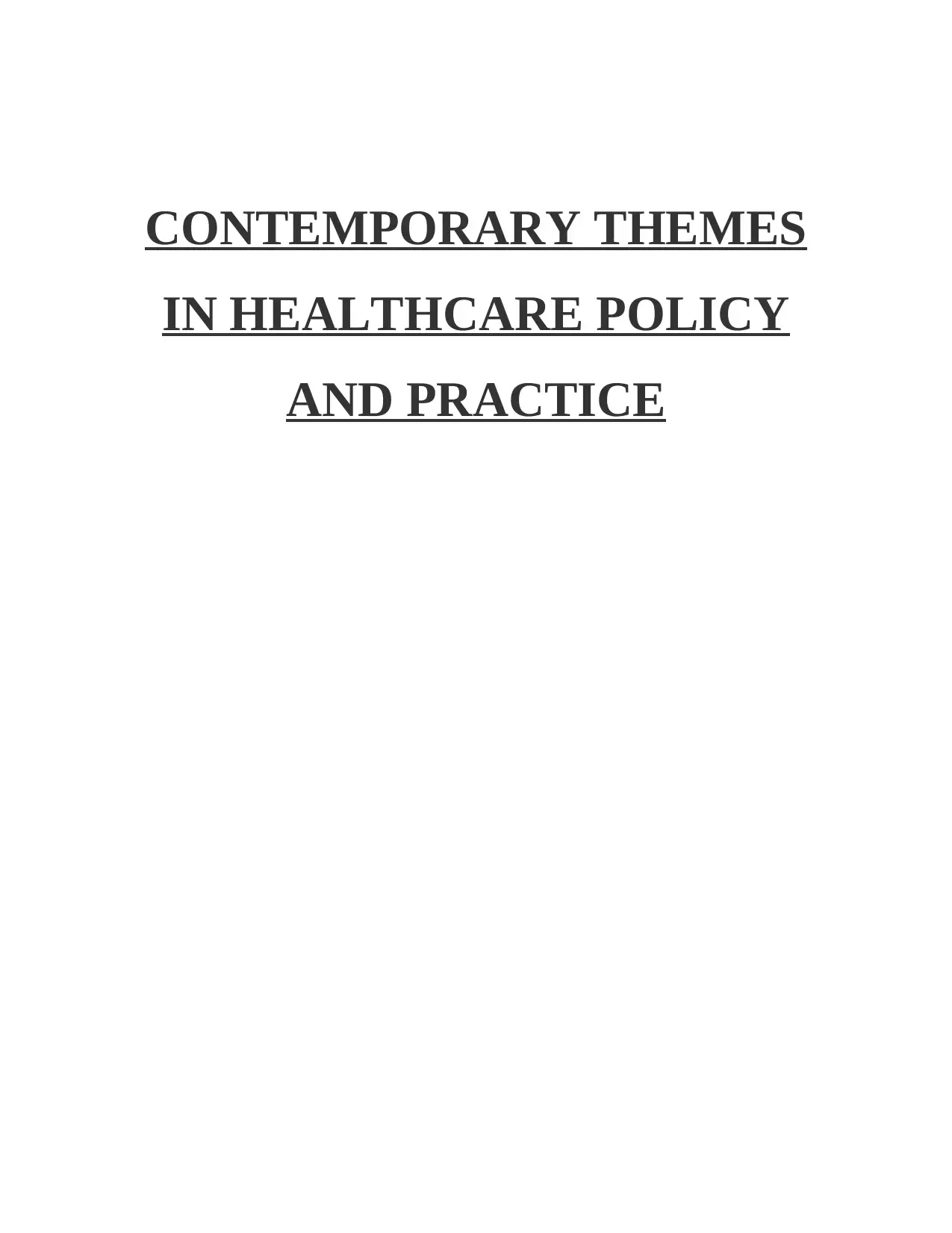
CONTEMPORARY THEMES
IN HEALTHCARE POLICY
AND PRACTICE
IN HEALTHCARE POLICY
AND PRACTICE
Paraphrase This Document
Need a fresh take? Get an instant paraphrase of this document with our AI Paraphraser
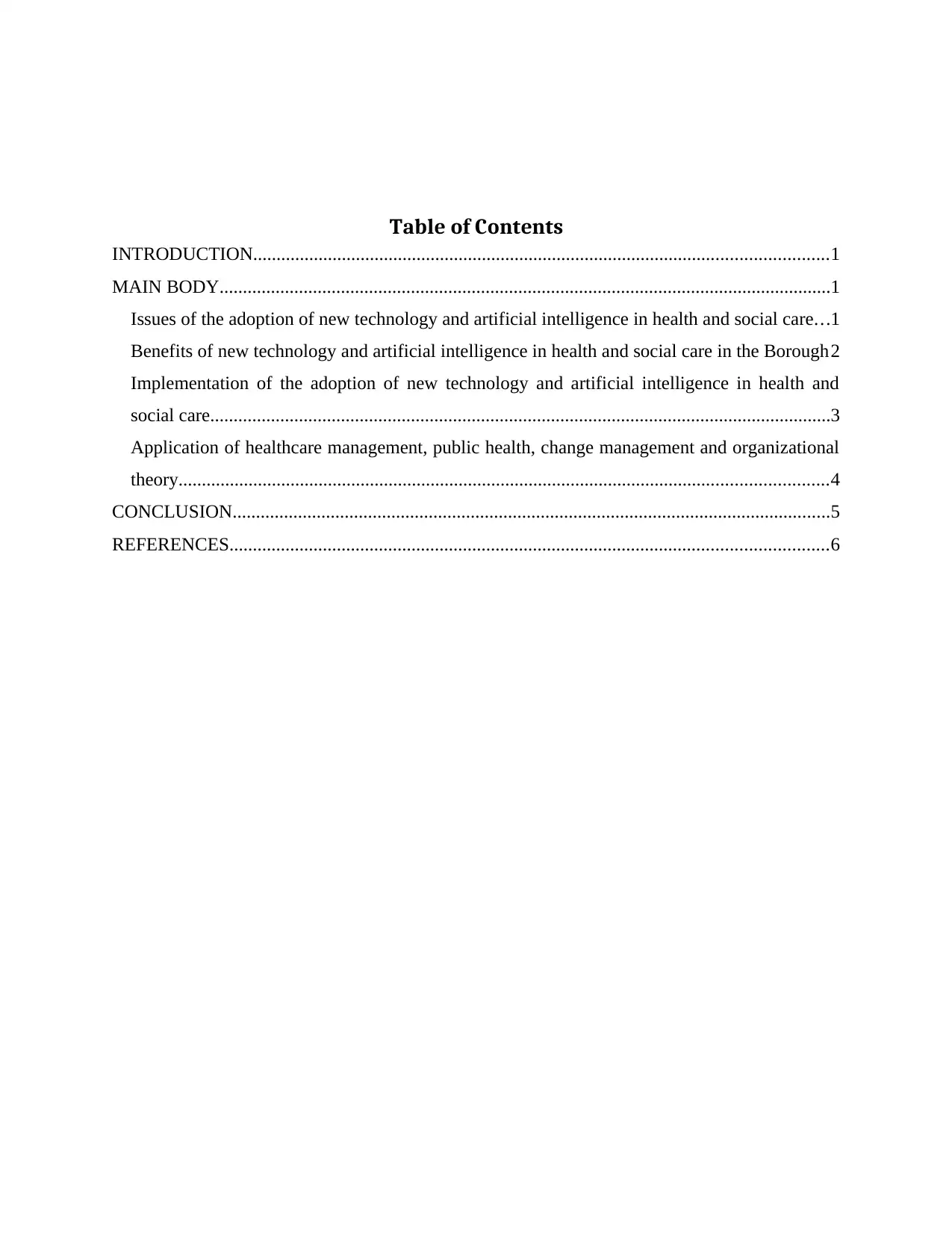
Table of Contents
INTRODUCTION...........................................................................................................................1
MAIN BODY...................................................................................................................................1
Issues of the adoption of new technology and artificial intelligence in health and social care...1
Benefits of new technology and artificial intelligence in health and social care in the Borough2
Implementation of the adoption of new technology and artificial intelligence in health and
social care.....................................................................................................................................3
Application of healthcare management, public health, change management and organizational
theory...........................................................................................................................................4
CONCLUSION................................................................................................................................5
REFERENCES................................................................................................................................6
INTRODUCTION...........................................................................................................................1
MAIN BODY...................................................................................................................................1
Issues of the adoption of new technology and artificial intelligence in health and social care...1
Benefits of new technology and artificial intelligence in health and social care in the Borough2
Implementation of the adoption of new technology and artificial intelligence in health and
social care.....................................................................................................................................3
Application of healthcare management, public health, change management and organizational
theory...........................................................................................................................................4
CONCLUSION................................................................................................................................5
REFERENCES................................................................................................................................6
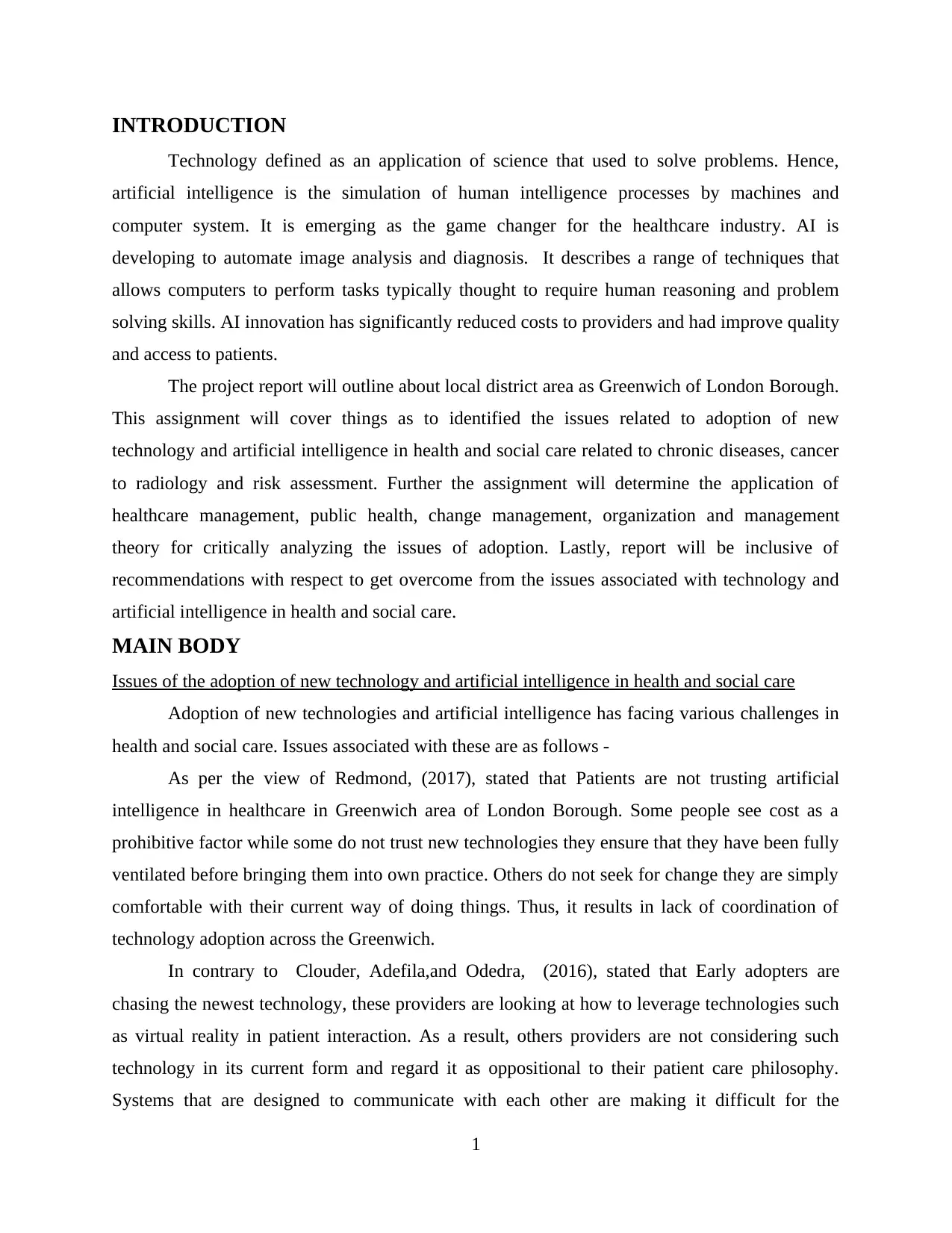
INTRODUCTION
Technology defined as an application of science that used to solve problems. Hence,
artificial intelligence is the simulation of human intelligence processes by machines and
computer system. It is emerging as the game changer for the healthcare industry. AI is
developing to automate image analysis and diagnosis. It describes a range of techniques that
allows computers to perform tasks typically thought to require human reasoning and problem
solving skills. AI innovation has significantly reduced costs to providers and had improve quality
and access to patients.
The project report will outline about local district area as Greenwich of London Borough.
This assignment will cover things as to identified the issues related to adoption of new
technology and artificial intelligence in health and social care related to chronic diseases, cancer
to radiology and risk assessment. Further the assignment will determine the application of
healthcare management, public health, change management, organization and management
theory for critically analyzing the issues of adoption. Lastly, report will be inclusive of
recommendations with respect to get overcome from the issues associated with technology and
artificial intelligence in health and social care.
MAIN BODY
Issues of the adoption of new technology and artificial intelligence in health and social care
Adoption of new technologies and artificial intelligence has facing various challenges in
health and social care. Issues associated with these are as follows -
As per the view of Redmond, (2017), stated that Patients are not trusting artificial
intelligence in healthcare in Greenwich area of London Borough. Some people see cost as a
prohibitive factor while some do not trust new technologies they ensure that they have been fully
ventilated before bringing them into own practice. Others do not seek for change they are simply
comfortable with their current way of doing things. Thus, it results in lack of coordination of
technology adoption across the Greenwich.
In contrary to Clouder, Adefila,and Odedra, (2016), stated that Early adopters are
chasing the newest technology, these providers are looking at how to leverage technologies such
as virtual reality in patient interaction. As a result, others providers are not considering such
technology in its current form and regard it as oppositional to their patient care philosophy.
Systems that are designed to communicate with each other are making it difficult for the
1
Technology defined as an application of science that used to solve problems. Hence,
artificial intelligence is the simulation of human intelligence processes by machines and
computer system. It is emerging as the game changer for the healthcare industry. AI is
developing to automate image analysis and diagnosis. It describes a range of techniques that
allows computers to perform tasks typically thought to require human reasoning and problem
solving skills. AI innovation has significantly reduced costs to providers and had improve quality
and access to patients.
The project report will outline about local district area as Greenwich of London Borough.
This assignment will cover things as to identified the issues related to adoption of new
technology and artificial intelligence in health and social care related to chronic diseases, cancer
to radiology and risk assessment. Further the assignment will determine the application of
healthcare management, public health, change management, organization and management
theory for critically analyzing the issues of adoption. Lastly, report will be inclusive of
recommendations with respect to get overcome from the issues associated with technology and
artificial intelligence in health and social care.
MAIN BODY
Issues of the adoption of new technology and artificial intelligence in health and social care
Adoption of new technologies and artificial intelligence has facing various challenges in
health and social care. Issues associated with these are as follows -
As per the view of Redmond, (2017), stated that Patients are not trusting artificial
intelligence in healthcare in Greenwich area of London Borough. Some people see cost as a
prohibitive factor while some do not trust new technologies they ensure that they have been fully
ventilated before bringing them into own practice. Others do not seek for change they are simply
comfortable with their current way of doing things. Thus, it results in lack of coordination of
technology adoption across the Greenwich.
In contrary to Clouder, Adefila,and Odedra, (2016), stated that Early adopters are
chasing the newest technology, these providers are looking at how to leverage technologies such
as virtual reality in patient interaction. As a result, others providers are not considering such
technology in its current form and regard it as oppositional to their patient care philosophy.
Systems that are designed to communicate with each other are making it difficult for the
1
⊘ This is a preview!⊘
Do you want full access?
Subscribe today to unlock all pages.

Trusted by 1+ million students worldwide
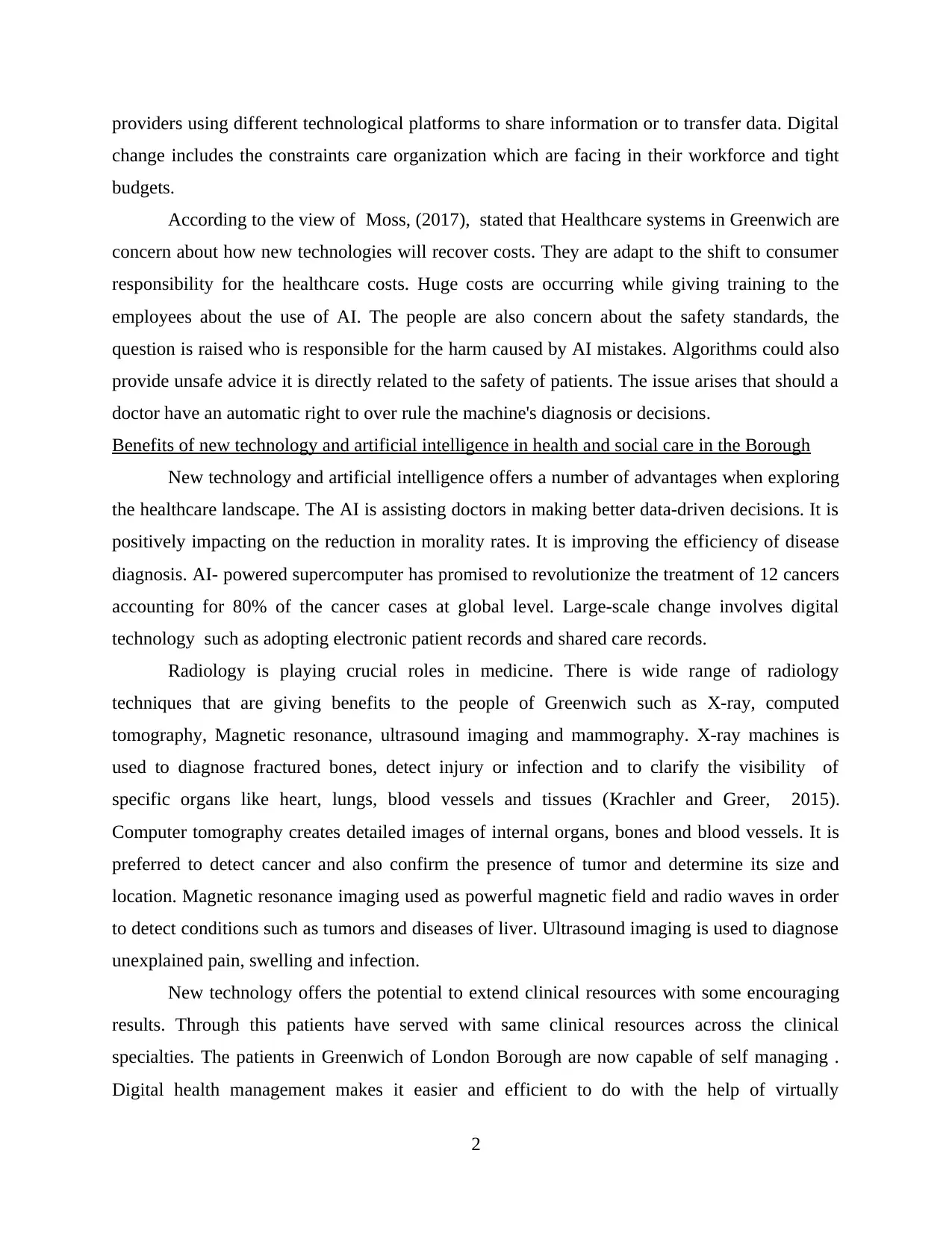
providers using different technological platforms to share information or to transfer data. Digital
change includes the constraints care organization which are facing in their workforce and tight
budgets.
According to the view of Moss, (2017), stated that Healthcare systems in Greenwich are
concern about how new technologies will recover costs. They are adapt to the shift to consumer
responsibility for the healthcare costs. Huge costs are occurring while giving training to the
employees about the use of AI. The people are also concern about the safety standards, the
question is raised who is responsible for the harm caused by AI mistakes. Algorithms could also
provide unsafe advice it is directly related to the safety of patients. The issue arises that should a
doctor have an automatic right to over rule the machine's diagnosis or decisions.
Benefits of new technology and artificial intelligence in health and social care in the Borough
New technology and artificial intelligence offers a number of advantages when exploring
the healthcare landscape. The AI is assisting doctors in making better data-driven decisions. It is
positively impacting on the reduction in morality rates. It is improving the efficiency of disease
diagnosis. AI- powered supercomputer has promised to revolutionize the treatment of 12 cancers
accounting for 80% of the cancer cases at global level. Large-scale change involves digital
technology such as adopting electronic patient records and shared care records.
Radiology is playing crucial roles in medicine. There is wide range of radiology
techniques that are giving benefits to the people of Greenwich such as X-ray, computed
tomography, Magnetic resonance, ultrasound imaging and mammography. X-ray machines is
used to diagnose fractured bones, detect injury or infection and to clarify the visibility of
specific organs like heart, lungs, blood vessels and tissues (Krachler and Greer, 2015).
Computer tomography creates detailed images of internal organs, bones and blood vessels. It is
preferred to detect cancer and also confirm the presence of tumor and determine its size and
location. Magnetic resonance imaging used as powerful magnetic field and radio waves in order
to detect conditions such as tumors and diseases of liver. Ultrasound imaging is used to diagnose
unexplained pain, swelling and infection.
New technology offers the potential to extend clinical resources with some encouraging
results. Through this patients have served with same clinical resources across the clinical
specialties. The patients in Greenwich of London Borough are now capable of self managing .
Digital health management makes it easier and efficient to do with the help of virtually
2
change includes the constraints care organization which are facing in their workforce and tight
budgets.
According to the view of Moss, (2017), stated that Healthcare systems in Greenwich are
concern about how new technologies will recover costs. They are adapt to the shift to consumer
responsibility for the healthcare costs. Huge costs are occurring while giving training to the
employees about the use of AI. The people are also concern about the safety standards, the
question is raised who is responsible for the harm caused by AI mistakes. Algorithms could also
provide unsafe advice it is directly related to the safety of patients. The issue arises that should a
doctor have an automatic right to over rule the machine's diagnosis or decisions.
Benefits of new technology and artificial intelligence in health and social care in the Borough
New technology and artificial intelligence offers a number of advantages when exploring
the healthcare landscape. The AI is assisting doctors in making better data-driven decisions. It is
positively impacting on the reduction in morality rates. It is improving the efficiency of disease
diagnosis. AI- powered supercomputer has promised to revolutionize the treatment of 12 cancers
accounting for 80% of the cancer cases at global level. Large-scale change involves digital
technology such as adopting electronic patient records and shared care records.
Radiology is playing crucial roles in medicine. There is wide range of radiology
techniques that are giving benefits to the people of Greenwich such as X-ray, computed
tomography, Magnetic resonance, ultrasound imaging and mammography. X-ray machines is
used to diagnose fractured bones, detect injury or infection and to clarify the visibility of
specific organs like heart, lungs, blood vessels and tissues (Krachler and Greer, 2015).
Computer tomography creates detailed images of internal organs, bones and blood vessels. It is
preferred to detect cancer and also confirm the presence of tumor and determine its size and
location. Magnetic resonance imaging used as powerful magnetic field and radio waves in order
to detect conditions such as tumors and diseases of liver. Ultrasound imaging is used to diagnose
unexplained pain, swelling and infection.
New technology offers the potential to extend clinical resources with some encouraging
results. Through this patients have served with same clinical resources across the clinical
specialties. The patients in Greenwich of London Borough are now capable of self managing .
Digital health management makes it easier and efficient to do with the help of virtually
2
Paraphrase This Document
Need a fresh take? Get an instant paraphrase of this document with our AI Paraphraser
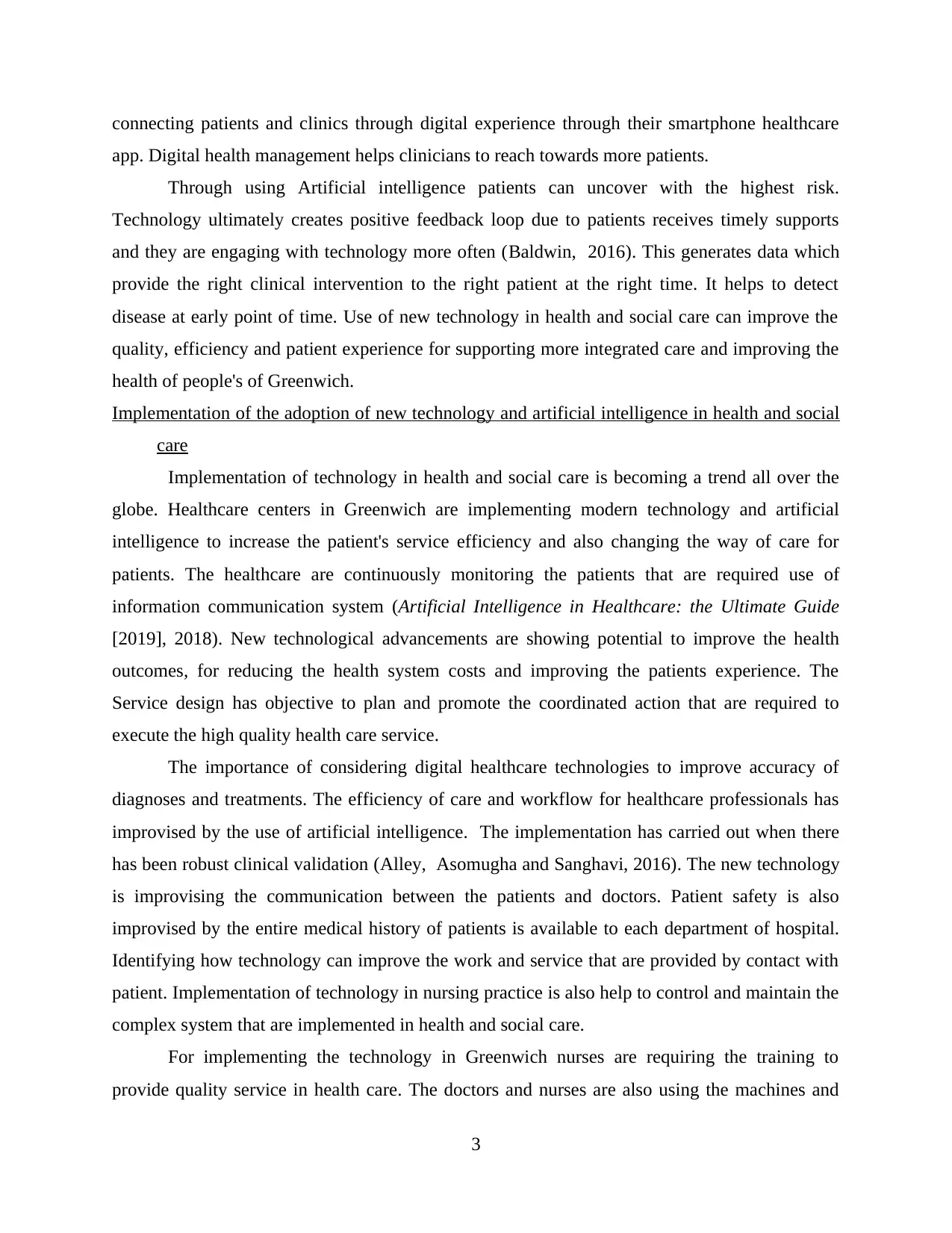
connecting patients and clinics through digital experience through their smartphone healthcare
app. Digital health management helps clinicians to reach towards more patients.
Through using Artificial intelligence patients can uncover with the highest risk.
Technology ultimately creates positive feedback loop due to patients receives timely supports
and they are engaging with technology more often (Baldwin, 2016). This generates data which
provide the right clinical intervention to the right patient at the right time. It helps to detect
disease at early point of time. Use of new technology in health and social care can improve the
quality, efficiency and patient experience for supporting more integrated care and improving the
health of people's of Greenwich.
Implementation of the adoption of new technology and artificial intelligence in health and social
care
Implementation of technology in health and social care is becoming a trend all over the
globe. Healthcare centers in Greenwich are implementing modern technology and artificial
intelligence to increase the patient's service efficiency and also changing the way of care for
patients. The healthcare are continuously monitoring the patients that are required use of
information communication system (Artificial Intelligence in Healthcare: the Ultimate Guide
[2019], 2018). New technological advancements are showing potential to improve the health
outcomes, for reducing the health system costs and improving the patients experience. The
Service design has objective to plan and promote the coordinated action that are required to
execute the high quality health care service.
The importance of considering digital healthcare technologies to improve accuracy of
diagnoses and treatments. The efficiency of care and workflow for healthcare professionals has
improvised by the use of artificial intelligence. The implementation has carried out when there
has been robust clinical validation (Alley, Asomugha and Sanghavi, 2016). The new technology
is improvising the communication between the patients and doctors. Patient safety is also
improvised by the entire medical history of patients is available to each department of hospital.
Identifying how technology can improve the work and service that are provided by contact with
patient. Implementation of technology in nursing practice is also help to control and maintain the
complex system that are implemented in health and social care.
For implementing the technology in Greenwich nurses are requiring the training to
provide quality service in health care. The doctors and nurses are also using the machines and
3
app. Digital health management helps clinicians to reach towards more patients.
Through using Artificial intelligence patients can uncover with the highest risk.
Technology ultimately creates positive feedback loop due to patients receives timely supports
and they are engaging with technology more often (Baldwin, 2016). This generates data which
provide the right clinical intervention to the right patient at the right time. It helps to detect
disease at early point of time. Use of new technology in health and social care can improve the
quality, efficiency and patient experience for supporting more integrated care and improving the
health of people's of Greenwich.
Implementation of the adoption of new technology and artificial intelligence in health and social
care
Implementation of technology in health and social care is becoming a trend all over the
globe. Healthcare centers in Greenwich are implementing modern technology and artificial
intelligence to increase the patient's service efficiency and also changing the way of care for
patients. The healthcare are continuously monitoring the patients that are required use of
information communication system (Artificial Intelligence in Healthcare: the Ultimate Guide
[2019], 2018). New technological advancements are showing potential to improve the health
outcomes, for reducing the health system costs and improving the patients experience. The
Service design has objective to plan and promote the coordinated action that are required to
execute the high quality health care service.
The importance of considering digital healthcare technologies to improve accuracy of
diagnoses and treatments. The efficiency of care and workflow for healthcare professionals has
improvised by the use of artificial intelligence. The implementation has carried out when there
has been robust clinical validation (Alley, Asomugha and Sanghavi, 2016). The new technology
is improvising the communication between the patients and doctors. Patient safety is also
improvised by the entire medical history of patients is available to each department of hospital.
Identifying how technology can improve the work and service that are provided by contact with
patient. Implementation of technology in nursing practice is also help to control and maintain the
complex system that are implemented in health and social care.
For implementing the technology in Greenwich nurses are requiring the training to
provide quality service in health care. The doctors and nurses are also using the machines and
3
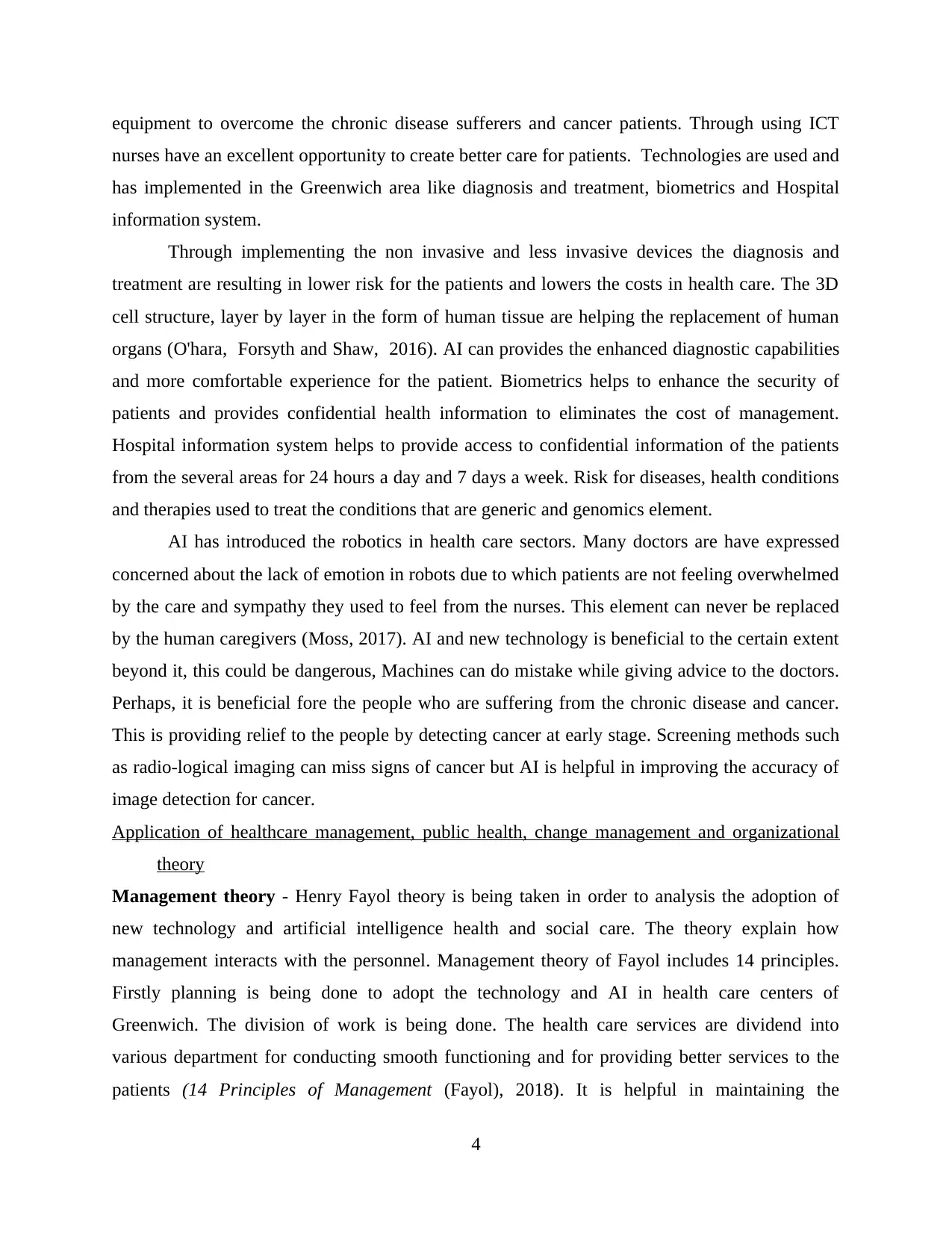
equipment to overcome the chronic disease sufferers and cancer patients. Through using ICT
nurses have an excellent opportunity to create better care for patients. Technologies are used and
has implemented in the Greenwich area like diagnosis and treatment, biometrics and Hospital
information system.
Through implementing the non invasive and less invasive devices the diagnosis and
treatment are resulting in lower risk for the patients and lowers the costs in health care. The 3D
cell structure, layer by layer in the form of human tissue are helping the replacement of human
organs (O'hara, Forsyth and Shaw, 2016). AI can provides the enhanced diagnostic capabilities
and more comfortable experience for the patient. Biometrics helps to enhance the security of
patients and provides confidential health information to eliminates the cost of management.
Hospital information system helps to provide access to confidential information of the patients
from the several areas for 24 hours a day and 7 days a week. Risk for diseases, health conditions
and therapies used to treat the conditions that are generic and genomics element.
AI has introduced the robotics in health care sectors. Many doctors are have expressed
concerned about the lack of emotion in robots due to which patients are not feeling overwhelmed
by the care and sympathy they used to feel from the nurses. This element can never be replaced
by the human caregivers (Moss, 2017). AI and new technology is beneficial to the certain extent
beyond it, this could be dangerous, Machines can do mistake while giving advice to the doctors.
Perhaps, it is beneficial fore the people who are suffering from the chronic disease and cancer.
This is providing relief to the people by detecting cancer at early stage. Screening methods such
as radio-logical imaging can miss signs of cancer but AI is helpful in improving the accuracy of
image detection for cancer.
Application of healthcare management, public health, change management and organizational
theory
Management theory - Henry Fayol theory is being taken in order to analysis the adoption of
new technology and artificial intelligence health and social care. The theory explain how
management interacts with the personnel. Management theory of Fayol includes 14 principles.
Firstly planning is being done to adopt the technology and AI in health care centers of
Greenwich. The division of work is being done. The health care services are dividend into
various department for conducting smooth functioning and for providing better services to the
patients (14 Principles of Management (Fayol), 2018). It is helpful in maintaining the
4
nurses have an excellent opportunity to create better care for patients. Technologies are used and
has implemented in the Greenwich area like diagnosis and treatment, biometrics and Hospital
information system.
Through implementing the non invasive and less invasive devices the diagnosis and
treatment are resulting in lower risk for the patients and lowers the costs in health care. The 3D
cell structure, layer by layer in the form of human tissue are helping the replacement of human
organs (O'hara, Forsyth and Shaw, 2016). AI can provides the enhanced diagnostic capabilities
and more comfortable experience for the patient. Biometrics helps to enhance the security of
patients and provides confidential health information to eliminates the cost of management.
Hospital information system helps to provide access to confidential information of the patients
from the several areas for 24 hours a day and 7 days a week. Risk for diseases, health conditions
and therapies used to treat the conditions that are generic and genomics element.
AI has introduced the robotics in health care sectors. Many doctors are have expressed
concerned about the lack of emotion in robots due to which patients are not feeling overwhelmed
by the care and sympathy they used to feel from the nurses. This element can never be replaced
by the human caregivers (Moss, 2017). AI and new technology is beneficial to the certain extent
beyond it, this could be dangerous, Machines can do mistake while giving advice to the doctors.
Perhaps, it is beneficial fore the people who are suffering from the chronic disease and cancer.
This is providing relief to the people by detecting cancer at early stage. Screening methods such
as radio-logical imaging can miss signs of cancer but AI is helpful in improving the accuracy of
image detection for cancer.
Application of healthcare management, public health, change management and organizational
theory
Management theory - Henry Fayol theory is being taken in order to analysis the adoption of
new technology and artificial intelligence health and social care. The theory explain how
management interacts with the personnel. Management theory of Fayol includes 14 principles.
Firstly planning is being done to adopt the technology and AI in health care centers of
Greenwich. The division of work is being done. The health care services are dividend into
various department for conducting smooth functioning and for providing better services to the
patients (14 Principles of Management (Fayol), 2018). It is helpful in maintaining the
4
⊘ This is a preview!⊘
Do you want full access?
Subscribe today to unlock all pages.

Trusted by 1+ million students worldwide
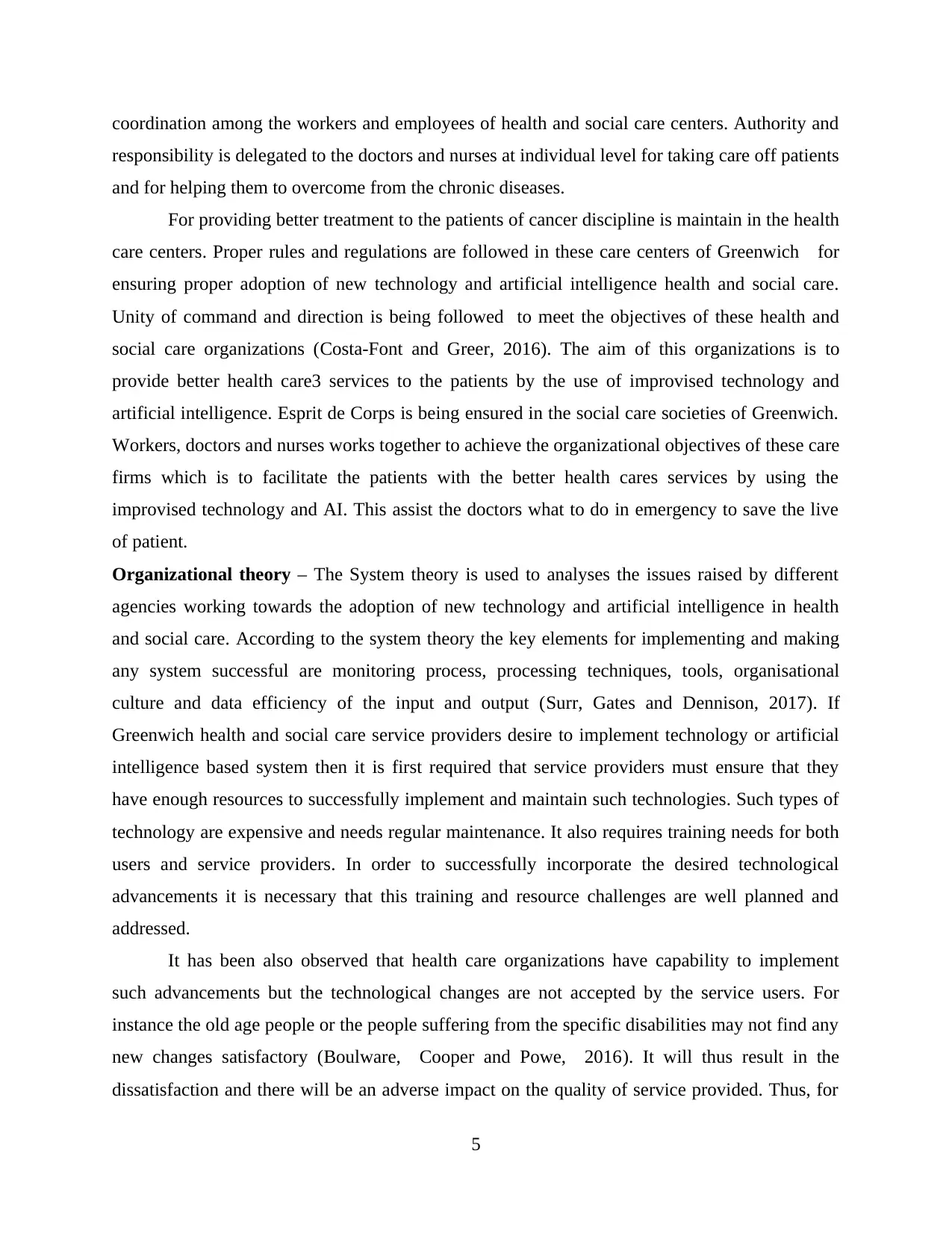
coordination among the workers and employees of health and social care centers. Authority and
responsibility is delegated to the doctors and nurses at individual level for taking care off patients
and for helping them to overcome from the chronic diseases.
For providing better treatment to the patients of cancer discipline is maintain in the health
care centers. Proper rules and regulations are followed in these care centers of Greenwich for
ensuring proper adoption of new technology and artificial intelligence health and social care.
Unity of command and direction is being followed to meet the objectives of these health and
social care organizations (Costa-Font and Greer, 2016). The aim of this organizations is to
provide better health care3 services to the patients by the use of improvised technology and
artificial intelligence. Esprit de Corps is being ensured in the social care societies of Greenwich.
Workers, doctors and nurses works together to achieve the organizational objectives of these care
firms which is to facilitate the patients with the better health cares services by using the
improvised technology and AI. This assist the doctors what to do in emergency to save the live
of patient.
Organizational theory – The System theory is used to analyses the issues raised by different
agencies working towards the adoption of new technology and artificial intelligence in health
and social care. According to the system theory the key elements for implementing and making
any system successful are monitoring process, processing techniques, tools, organisational
culture and data efficiency of the input and output (Surr, Gates and Dennison, 2017). If
Greenwich health and social care service providers desire to implement technology or artificial
intelligence based system then it is first required that service providers must ensure that they
have enough resources to successfully implement and maintain such technologies. Such types of
technology are expensive and needs regular maintenance. It also requires training needs for both
users and service providers. In order to successfully incorporate the desired technological
advancements it is necessary that this training and resource challenges are well planned and
addressed.
It has been also observed that health care organizations have capability to implement
such advancements but the technological changes are not accepted by the service users. For
instance the old age people or the people suffering from the specific disabilities may not find any
new changes satisfactory (Boulware, Cooper and Powe, 2016). It will thus result in the
dissatisfaction and there will be an adverse impact on the quality of service provided. Thus, for
5
responsibility is delegated to the doctors and nurses at individual level for taking care off patients
and for helping them to overcome from the chronic diseases.
For providing better treatment to the patients of cancer discipline is maintain in the health
care centers. Proper rules and regulations are followed in these care centers of Greenwich for
ensuring proper adoption of new technology and artificial intelligence health and social care.
Unity of command and direction is being followed to meet the objectives of these health and
social care organizations (Costa-Font and Greer, 2016). The aim of this organizations is to
provide better health care3 services to the patients by the use of improvised technology and
artificial intelligence. Esprit de Corps is being ensured in the social care societies of Greenwich.
Workers, doctors and nurses works together to achieve the organizational objectives of these care
firms which is to facilitate the patients with the better health cares services by using the
improvised technology and AI. This assist the doctors what to do in emergency to save the live
of patient.
Organizational theory – The System theory is used to analyses the issues raised by different
agencies working towards the adoption of new technology and artificial intelligence in health
and social care. According to the system theory the key elements for implementing and making
any system successful are monitoring process, processing techniques, tools, organisational
culture and data efficiency of the input and output (Surr, Gates and Dennison, 2017). If
Greenwich health and social care service providers desire to implement technology or artificial
intelligence based system then it is first required that service providers must ensure that they
have enough resources to successfully implement and maintain such technologies. Such types of
technology are expensive and needs regular maintenance. It also requires training needs for both
users and service providers. In order to successfully incorporate the desired technological
advancements it is necessary that this training and resource challenges are well planned and
addressed.
It has been also observed that health care organizations have capability to implement
such advancements but the technological changes are not accepted by the service users. For
instance the old age people or the people suffering from the specific disabilities may not find any
new changes satisfactory (Boulware, Cooper and Powe, 2016). It will thus result in the
dissatisfaction and there will be an adverse impact on the quality of service provided. Thus, for
5
Paraphrase This Document
Need a fresh take? Get an instant paraphrase of this document with our AI Paraphraser
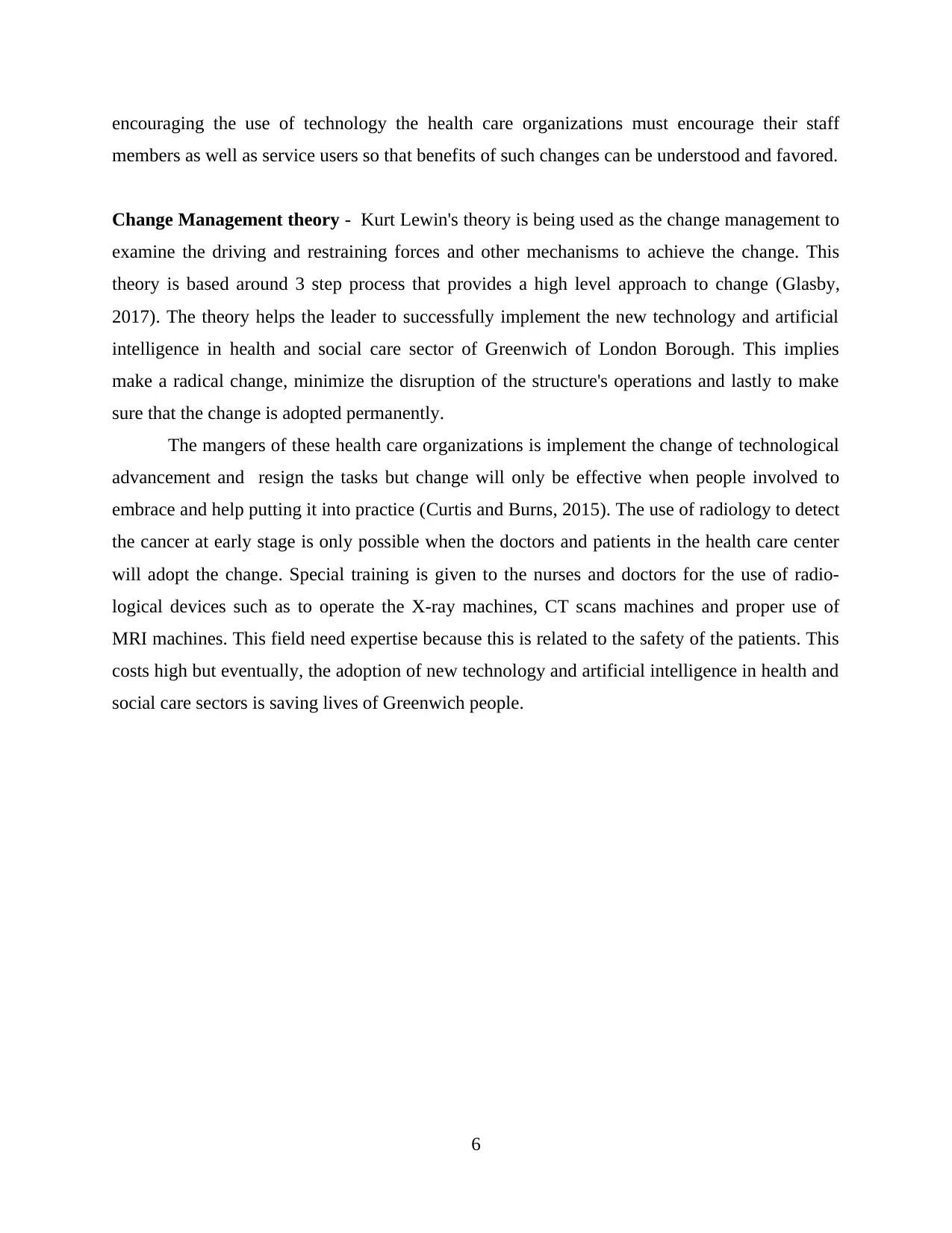
encouraging the use of technology the health care organizations must encourage their staff
members as well as service users so that benefits of such changes can be understood and favored.
Change Management theory - Kurt Lewin's theory is being used as the change management to
examine the driving and restraining forces and other mechanisms to achieve the change. This
theory is based around 3 step process that provides a high level approach to change (Glasby,
2017). The theory helps the leader to successfully implement the new technology and artificial
intelligence in health and social care sector of Greenwich of London Borough. This implies
make a radical change, minimize the disruption of the structure's operations and lastly to make
sure that the change is adopted permanently.
The mangers of these health care organizations is implement the change of technological
advancement and resign the tasks but change will only be effective when people involved to
embrace and help putting it into practice (Curtis and Burns, 2015). The use of radiology to detect
the cancer at early stage is only possible when the doctors and patients in the health care center
will adopt the change. Special training is given to the nurses and doctors for the use of radio-
logical devices such as to operate the X-ray machines, CT scans machines and proper use of
MRI machines. This field need expertise because this is related to the safety of the patients. This
costs high but eventually, the adoption of new technology and artificial intelligence in health and
social care sectors is saving lives of Greenwich people.
6
members as well as service users so that benefits of such changes can be understood and favored.
Change Management theory - Kurt Lewin's theory is being used as the change management to
examine the driving and restraining forces and other mechanisms to achieve the change. This
theory is based around 3 step process that provides a high level approach to change (Glasby,
2017). The theory helps the leader to successfully implement the new technology and artificial
intelligence in health and social care sector of Greenwich of London Borough. This implies
make a radical change, minimize the disruption of the structure's operations and lastly to make
sure that the change is adopted permanently.
The mangers of these health care organizations is implement the change of technological
advancement and resign the tasks but change will only be effective when people involved to
embrace and help putting it into practice (Curtis and Burns, 2015). The use of radiology to detect
the cancer at early stage is only possible when the doctors and patients in the health care center
will adopt the change. Special training is given to the nurses and doctors for the use of radio-
logical devices such as to operate the X-ray machines, CT scans machines and proper use of
MRI machines. This field need expertise because this is related to the safety of the patients. This
costs high but eventually, the adoption of new technology and artificial intelligence in health and
social care sectors is saving lives of Greenwich people.
6
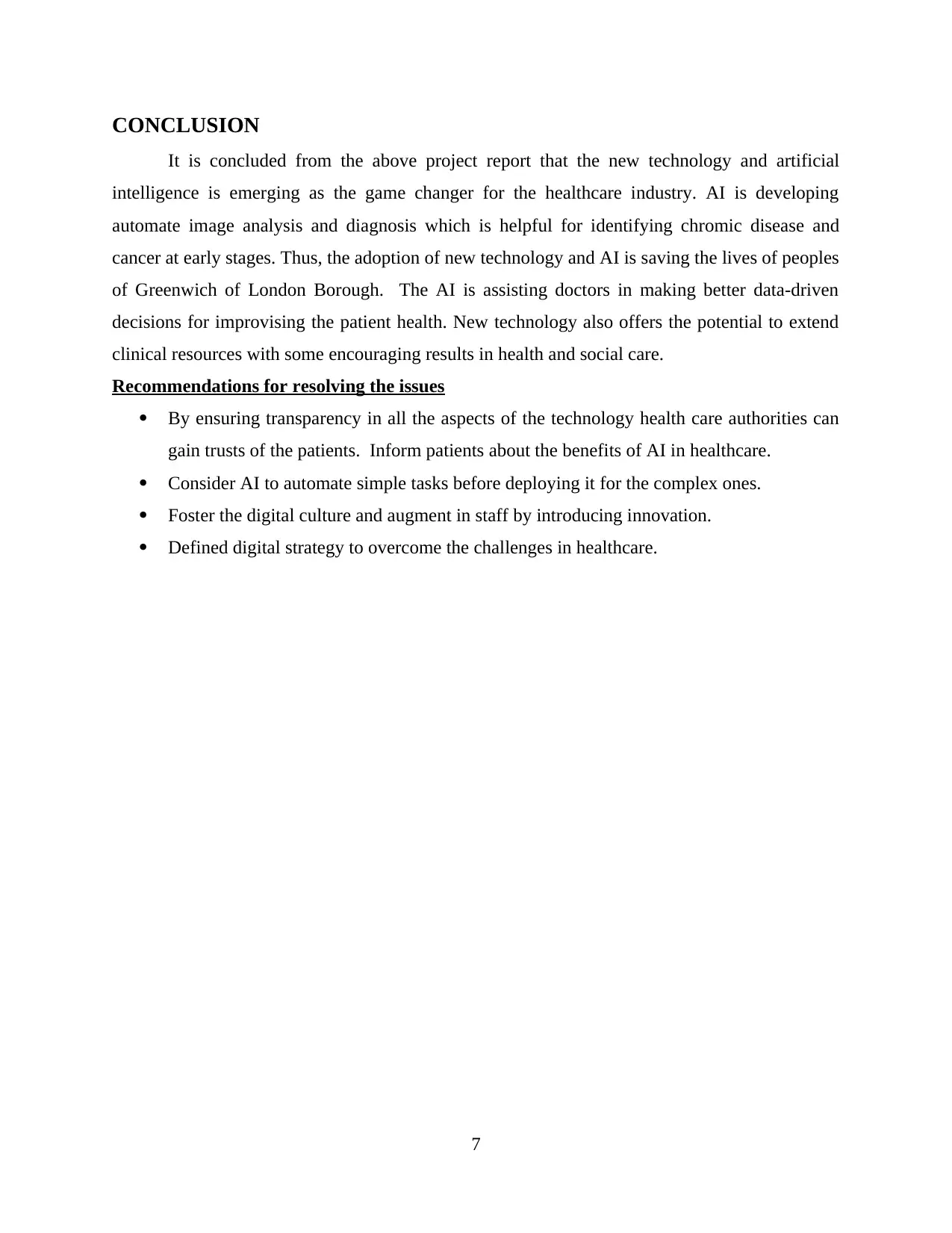
CONCLUSION
It is concluded from the above project report that the new technology and artificial
intelligence is emerging as the game changer for the healthcare industry. AI is developing
automate image analysis and diagnosis which is helpful for identifying chromic disease and
cancer at early stages. Thus, the adoption of new technology and AI is saving the lives of peoples
of Greenwich of London Borough. The AI is assisting doctors in making better data-driven
decisions for improvising the patient health. New technology also offers the potential to extend
clinical resources with some encouraging results in health and social care.
Recommendations for resolving the issues
By ensuring transparency in all the aspects of the technology health care authorities can
gain trusts of the patients. Inform patients about the benefits of AI in healthcare.
Consider AI to automate simple tasks before deploying it for the complex ones.
Foster the digital culture and augment in staff by introducing innovation.
Defined digital strategy to overcome the challenges in healthcare.
7
It is concluded from the above project report that the new technology and artificial
intelligence is emerging as the game changer for the healthcare industry. AI is developing
automate image analysis and diagnosis which is helpful for identifying chromic disease and
cancer at early stages. Thus, the adoption of new technology and AI is saving the lives of peoples
of Greenwich of London Borough. The AI is assisting doctors in making better data-driven
decisions for improvising the patient health. New technology also offers the potential to extend
clinical resources with some encouraging results in health and social care.
Recommendations for resolving the issues
By ensuring transparency in all the aspects of the technology health care authorities can
gain trusts of the patients. Inform patients about the benefits of AI in healthcare.
Consider AI to automate simple tasks before deploying it for the complex ones.
Foster the digital culture and augment in staff by introducing innovation.
Defined digital strategy to overcome the challenges in healthcare.
7
⊘ This is a preview!⊘
Do you want full access?
Subscribe today to unlock all pages.

Trusted by 1+ million students worldwide
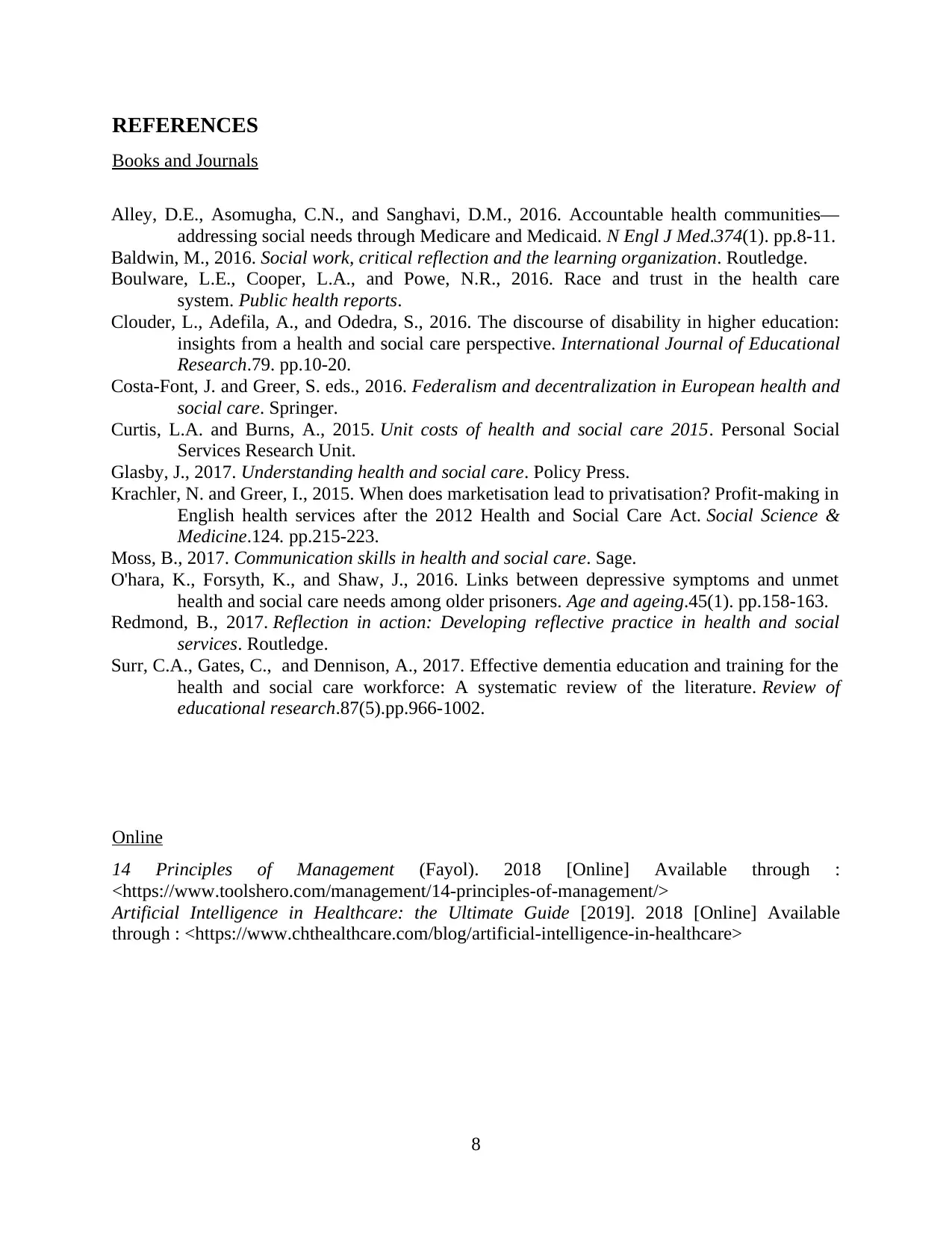
REFERENCES
Books and Journals
Alley, D.E., Asomugha, C.N., and Sanghavi, D.M., 2016. Accountable health communities—
addressing social needs through Medicare and Medicaid. N Engl J Med.374(1). pp.8-11.
Baldwin, M., 2016. Social work, critical reflection and the learning organization. Routledge.
Boulware, L.E., Cooper, L.A., and Powe, N.R., 2016. Race and trust in the health care
system. Public health reports.
Clouder, L., Adefila, A., and Odedra, S., 2016. The discourse of disability in higher education:
insights from a health and social care perspective. International Journal of Educational
Research.79. pp.10-20.
Costa-Font, J. and Greer, S. eds., 2016. Federalism and decentralization in European health and
social care. Springer.
Curtis, L.A. and Burns, A., 2015. Unit costs of health and social care 2015. Personal Social
Services Research Unit.
Glasby, J., 2017. Understanding health and social care. Policy Press.
Krachler, N. and Greer, I., 2015. When does marketisation lead to privatisation? Profit-making in
English health services after the 2012 Health and Social Care Act. Social Science &
Medicine.124. pp.215-223.
Moss, B., 2017. Communication skills in health and social care. Sage.
O'hara, K., Forsyth, K., and Shaw, J., 2016. Links between depressive symptoms and unmet
health and social care needs among older prisoners. Age and ageing.45(1). pp.158-163.
Redmond, B., 2017. Reflection in action: Developing reflective practice in health and social
services. Routledge.
Surr, C.A., Gates, C., and Dennison, A., 2017. Effective dementia education and training for the
health and social care workforce: A systematic review of the literature. Review of
educational research.87(5).pp.966-1002.
Online
14 Principles of Management (Fayol). 2018 [Online] Available through :
<https://www.toolshero.com/management/14-principles-of-management/>
Artificial Intelligence in Healthcare: the Ultimate Guide [2019]. 2018 [Online] Available
through : <https://www.chthealthcare.com/blog/artificial-intelligence-in-healthcare>
8
Books and Journals
Alley, D.E., Asomugha, C.N., and Sanghavi, D.M., 2016. Accountable health communities—
addressing social needs through Medicare and Medicaid. N Engl J Med.374(1). pp.8-11.
Baldwin, M., 2016. Social work, critical reflection and the learning organization. Routledge.
Boulware, L.E., Cooper, L.A., and Powe, N.R., 2016. Race and trust in the health care
system. Public health reports.
Clouder, L., Adefila, A., and Odedra, S., 2016. The discourse of disability in higher education:
insights from a health and social care perspective. International Journal of Educational
Research.79. pp.10-20.
Costa-Font, J. and Greer, S. eds., 2016. Federalism and decentralization in European health and
social care. Springer.
Curtis, L.A. and Burns, A., 2015. Unit costs of health and social care 2015. Personal Social
Services Research Unit.
Glasby, J., 2017. Understanding health and social care. Policy Press.
Krachler, N. and Greer, I., 2015. When does marketisation lead to privatisation? Profit-making in
English health services after the 2012 Health and Social Care Act. Social Science &
Medicine.124. pp.215-223.
Moss, B., 2017. Communication skills in health and social care. Sage.
O'hara, K., Forsyth, K., and Shaw, J., 2016. Links between depressive symptoms and unmet
health and social care needs among older prisoners. Age and ageing.45(1). pp.158-163.
Redmond, B., 2017. Reflection in action: Developing reflective practice in health and social
services. Routledge.
Surr, C.A., Gates, C., and Dennison, A., 2017. Effective dementia education and training for the
health and social care workforce: A systematic review of the literature. Review of
educational research.87(5).pp.966-1002.
Online
14 Principles of Management (Fayol). 2018 [Online] Available through :
<https://www.toolshero.com/management/14-principles-of-management/>
Artificial Intelligence in Healthcare: the Ultimate Guide [2019]. 2018 [Online] Available
through : <https://www.chthealthcare.com/blog/artificial-intelligence-in-healthcare>
8
1 out of 10
Related Documents
Your All-in-One AI-Powered Toolkit for Academic Success.
+13062052269
info@desklib.com
Available 24*7 on WhatsApp / Email
![[object Object]](/_next/static/media/star-bottom.7253800d.svg)
Unlock your academic potential
Copyright © 2020–2025 A2Z Services. All Rights Reserved. Developed and managed by ZUCOL.





